trailer CHEVROLET CAMARO 1994 4.G Owners Manual
[x] Cancel search | Manufacturer: CHEVROLET, Model Year: 1994, Model line: CAMARO, Model: CHEVROLET CAMARO 1994 4.GPages: 292, PDF Size: 15.35 MB
Page 63 of 292
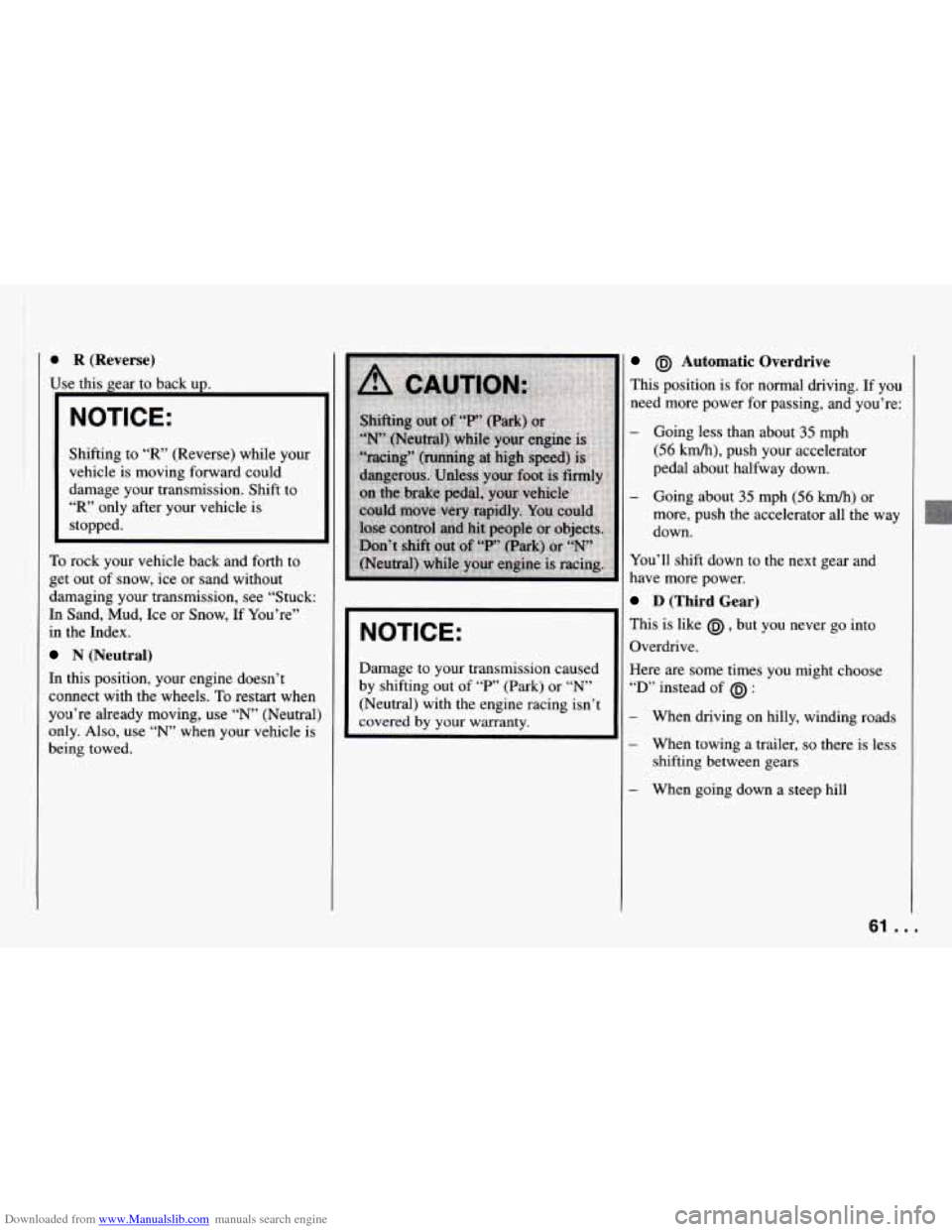
Downloaded from www.Manualslib.com manuals search engine i
0 R (Reverse)
$e this gear to back up.
NOTICE:
Shifting to “R’ (Reverse) while your
vehicle is moving forward could
damage your transmission. Shift to
“R’ only after your vehicle is
stopped.
To rock your vehicle back and forth to
get out of snow, ice or sand without
damaging your transmission, see “Stuck:
In Sand, Mud, Ice or Snow, If You’re’’
in the Index.
N (Neutral)
In this position, your engine doesn’t
connect with the wheels.
To restart when
you’re already moving, use
“N” (Neutral)
only. Also,
use “N” when your vehicle is
being towed.
NOTICE:
Damage to your transmission caused
by shifting out of
“P’ (Park) or “N’
(Neutral) with the engine racing isn’t
covered by your warranty.
@J Automatic Overdrive
This position is for normal driving. If you
need more power for passing,
and you’re:
- Going less than about 35 mph
(56 km/h), push your accelerator
pedal about halfway down.
- Going about 35 mph (56 km/h) or
more, push the accelerator all the way
down.
You’ll shift down to the next gear and
have more power.
D (Third Gear)
This is like @ , but you never go into
Overdrive.
Here are some times
you might choose
“D’ instead of @J :
When driving on hilly, winding roads
When towing a trailer,
so there is less
shifting between gears
When going down a steep hill
61 ...
Page 69 of 292
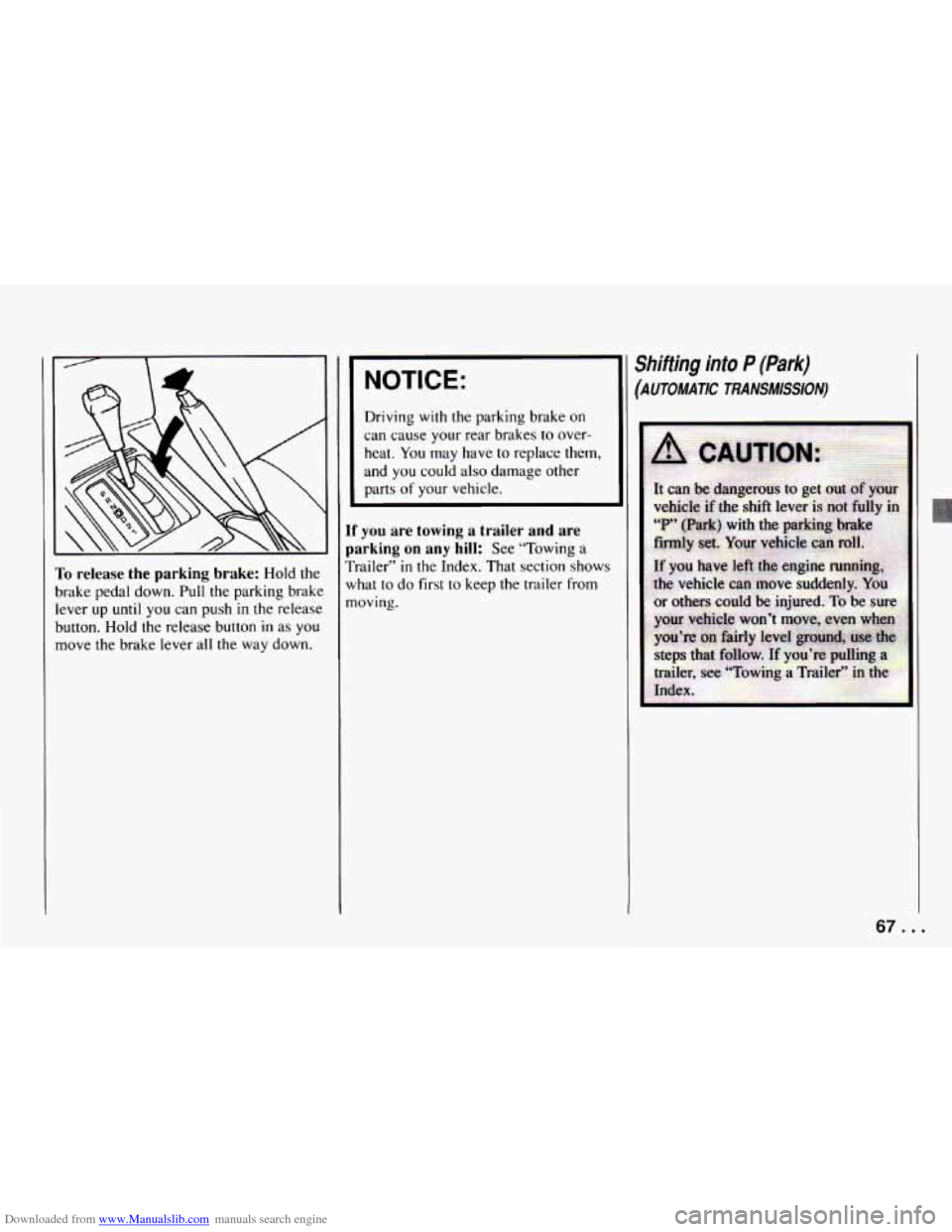
Downloaded from www.Manualslib.com manuals search engine ~ ~ ~~~ ib release the parking brake: Hold the
rake pedal down.
Pull the parking brake
zver
up until you can push in the release
wtton.
Hold the release button in as you
nove the brake lever all
the way down.
NOTICE:
Driving with the parking brake on
can cause your rear brakes to over-
heat.
You may have to replace them,
and you could also damage other
parts of your vehicle.
If you are towing a trailer and are
parking on any hill:
See “Towing a
Trailer”
in the Index. That section shows
what
to do first to keep the trailer from
moving.
Shifting into P (Park)
(AUTOMATIC TRANSMISSION)
67. .
Page 71 of 292
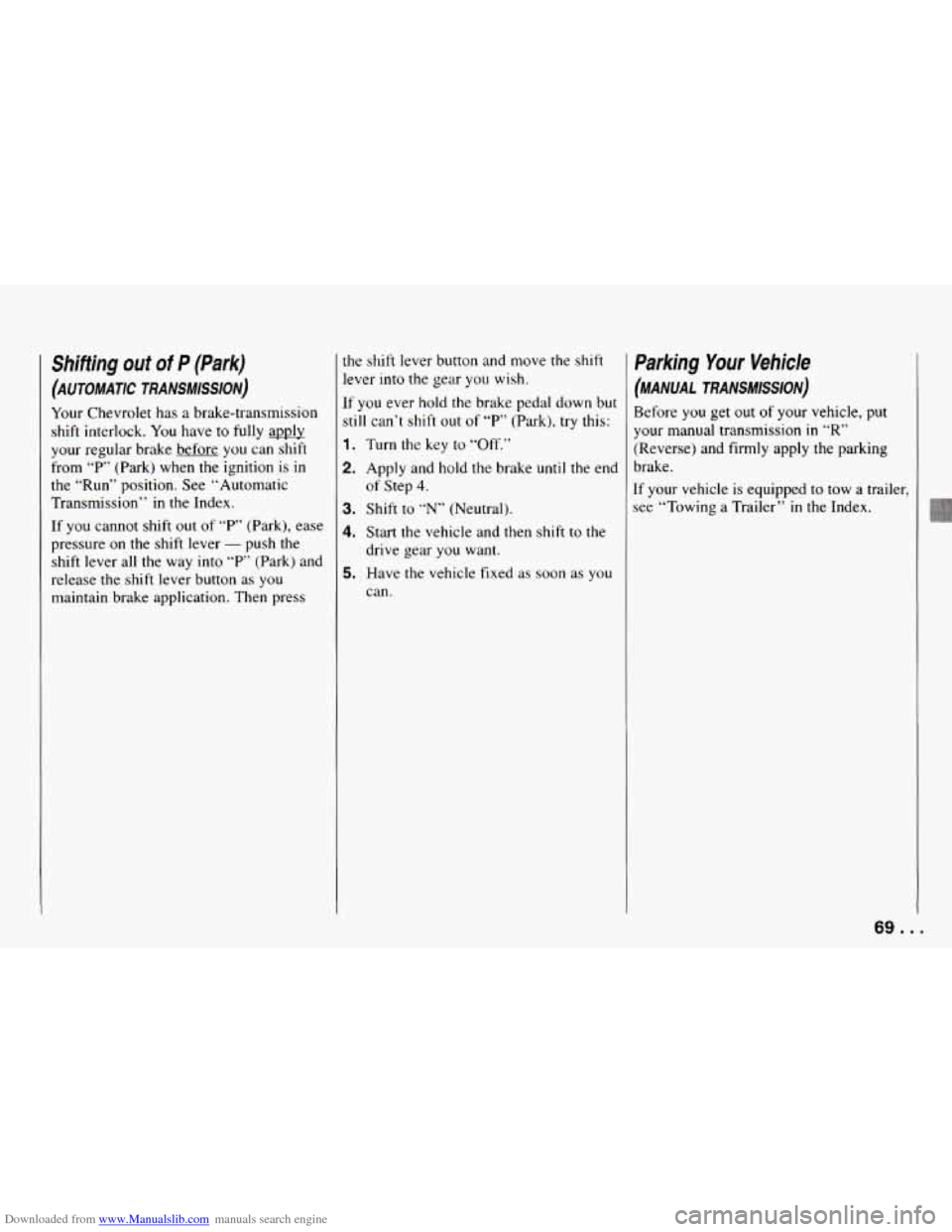
Downloaded from www.Manualslib.com manuals search engine Shifting out of P (Park)
[AUTOMATIC TRANSMISSION)
Your Chevrolet has a brake-transmission
shift interlock.
You have to fully apply
your regular brake before
you can shift
from
“P’ (Park) when the ignition is in
the
“Run” position. See “Automatic
Transmission” in the Index.
If you cannot shift out of “P’ (Park), ease
pressure on the shift lever
- push the
shift lever all the way into
“P’ (Park) and
release the shift lever button
as you
maintain brake application. Then press the
shift lever button and move the shift
lever into the gear you wish.
If you ever hold the brake pedal down but
still can’t shift out of “P” (Park), try this:
1. Turn the key to ‘bOff.”
2. Apply and hold the brake until the end
3. Shift to “N” (Neutral).
4. Start the vehicle and then shift to the
drive gear
you want.
of Step 4.
5. Have the vehicle fixed as soon as you
can.
Parking Your Vehicle
(MANUAL TRANSMISSION)
Before you get out of your vehicle, put
your
manual transmission in “R”
(Reverse) and firmly apply the parking
brake.
If your vehicle is equipped to tow a trailer,
see “Towing a Trailer”
in the Index.
69 ...
Page 73 of 292
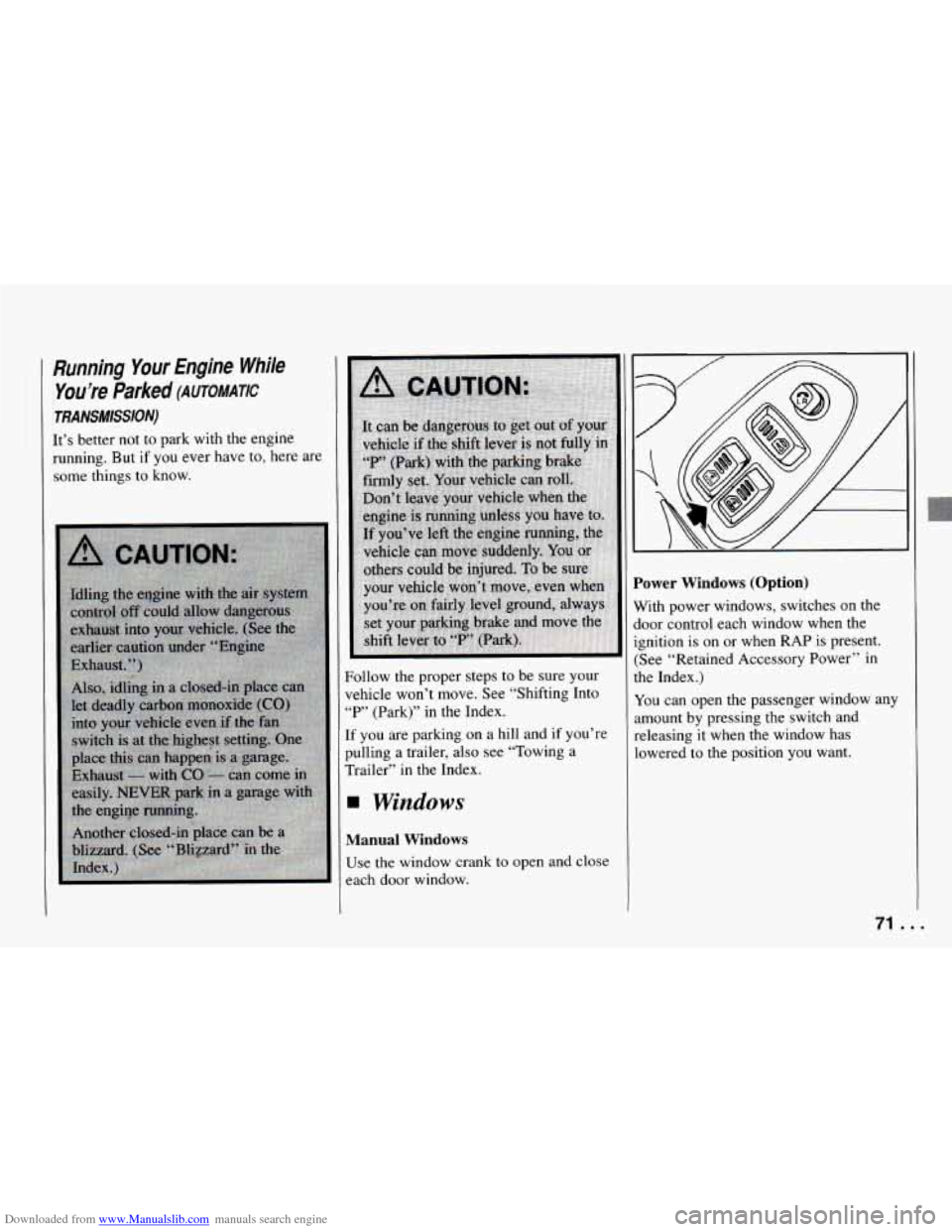
Downloaded from www.Manualslib.com manuals search engine Running Your Engine While You’re Parked
(AUTOMATIC
TRANSMISSION)
It’s better not to park with the engine
running. But if you ever have to, here are
some things to know.
Follow the proper steps to be sure your
vehicle won’t move. See “Shifting Into
“P’ (Park)” in the Index.
If
you are parking on a hill and if you’re
pulling a trailer, also see “Towing a
Trailer” in the Index.
Windows
Manual Windows
Use the window crank to open and close
each door window.
?ower Windows (Option)
Nith power windows, switches on the
loor control each window when the
gnition is
on or when RAP is present.
:See “Retained Accessory Power” in
he Index.)
Y‘ou can open the passenger window any
imount by pressing the switch and
-eleasing it when the window has
owered to the position you want.
74
Page 125 of 292
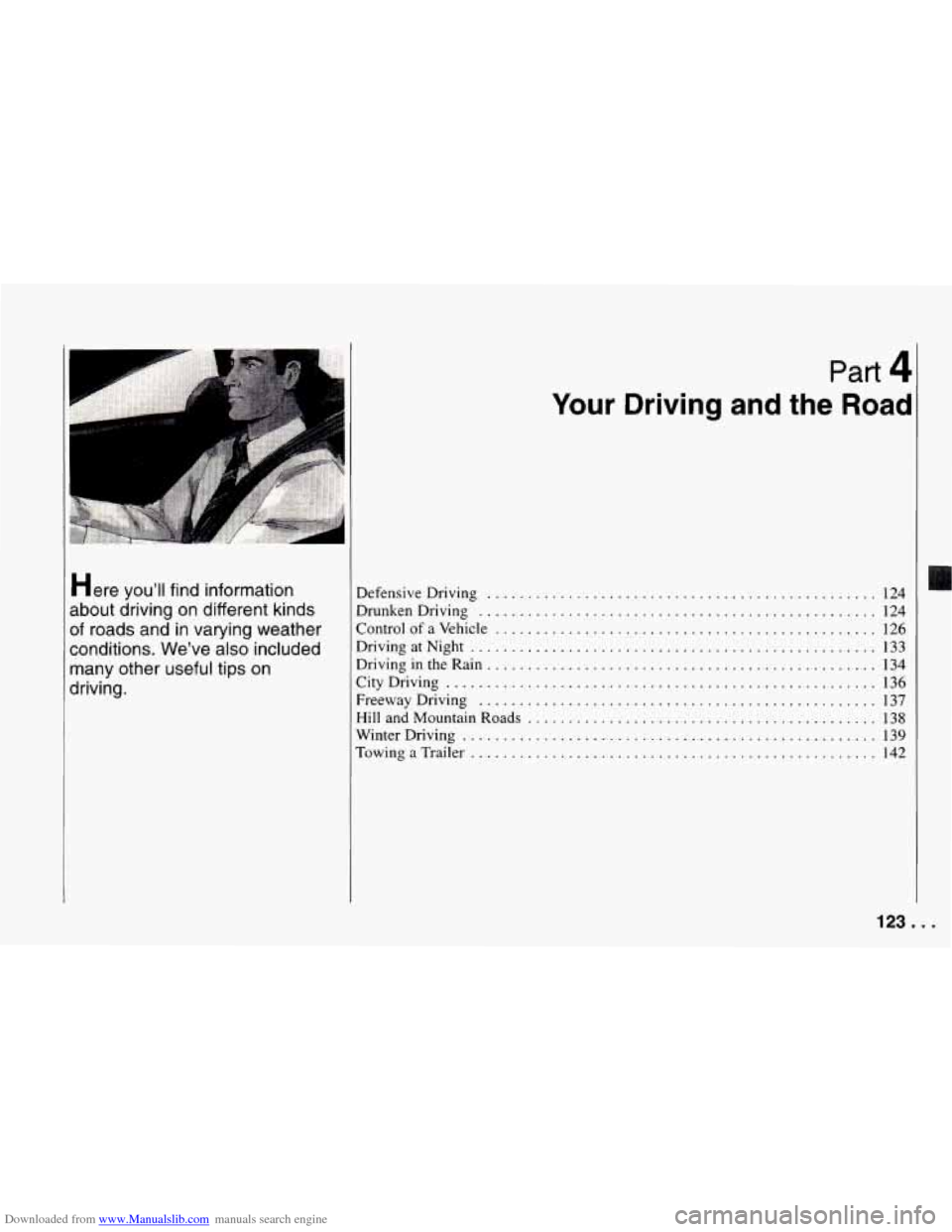
Downloaded from www.Manualslib.com manuals search engine Part 4
Here you’ll find information
about driving on different kinds of roads and in varying weather
conditions. We’ve also included
many other useful tips on
driving.
I
I
I
Your Driving and the Road
DefensiveDriving ................................................ 124
DrunkenDriving
................................................. 124
Control
of a Vehicle , . . . . . . . . . . . . . . . . . . . . . . . . . . . . - . . . . . . . . . . . . . . . . . 126
DrivingatNight
.................................................. 133
Driving in the Rain
. . . . . . . . . . . . . . . . . . . . . . . . . . . . . . . . . . . . . . . . . . . . . . . . 134
CityDriving
..................................................... 136
FreewayDriving
................................................. 137
Hill and Mountain Roads . . . . . . . . . . . . . . . . . . . . . . . . .
. . . . . . . . . . . . . . . . . . 138
WinterDriving
................................................... 139
TowingaTrailer
.................................................. 142
123 ...
Page 144 of 292
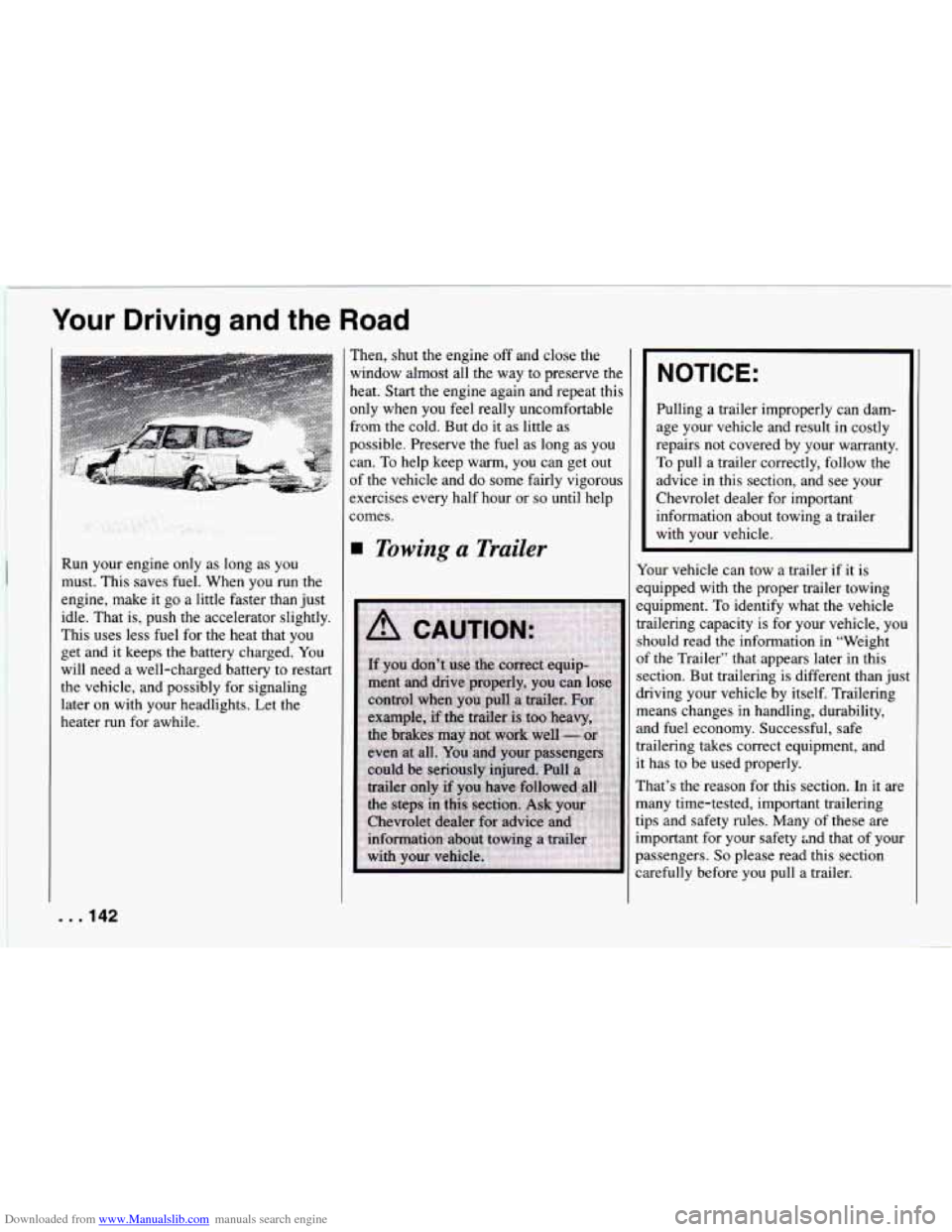
Downloaded from www.Manualslib.com manuals search engine Your Driving and the Road
Run your engine only as long as you
must. This saves fuel. When you run the
engine, make it go a little faster than just
idle. That is, push the accelerator slightly.
This uses less fuel for the heat that you
get and it keeps the battery charged.
You
will need a well-charged battery to restart
the vehicle, and possibly for signaling
later on with your headlights. Let the
heater run for awhile. Then,
shut the engine
off and close the
window almost all the way to preserve the
heat. Start the engine again and repeat this
only when you feel really uncomfortable
from the cold. But do it as little as
possible. Preserve the fuel as long as you
can. To help keep warm, you can get out
of the vehicle and do some fairly vigorous
exercises every half hour or
so until help
comes.
Towing a Trailer
NOTICE:
Pulling a trailer improperly can dam-
age your vehicle and result in costly
repairs not covered
by your warranty.
To pull a trailer correctly, follow the
advice
in this section, and see your
Chevrolet dealer for important
information about towing a trailer
with your vehicle.
Your vehicle can tow a trailer if it is
equipped with the proper trailer towing
equipment. To identify what the vehicle
trailering capacity is for your vehicle, you
should read the information in “Weight
of the Trailer” that appears later in this
section. But trailering is different than just
driving your vehicle by itself. Trailering
means changes in handling, durability,
and fuel economy. Successful, safe
trailering takes correct equipment, and
it has to be used properly.
That’s the reason for this section. In it are
many time-tested, important trailering
tips and safety rules. Many of these are
important for your safety md that of your
passengers.
So please read this section
carefully before you pull a trailer.
. . .142
Page 145 of 292
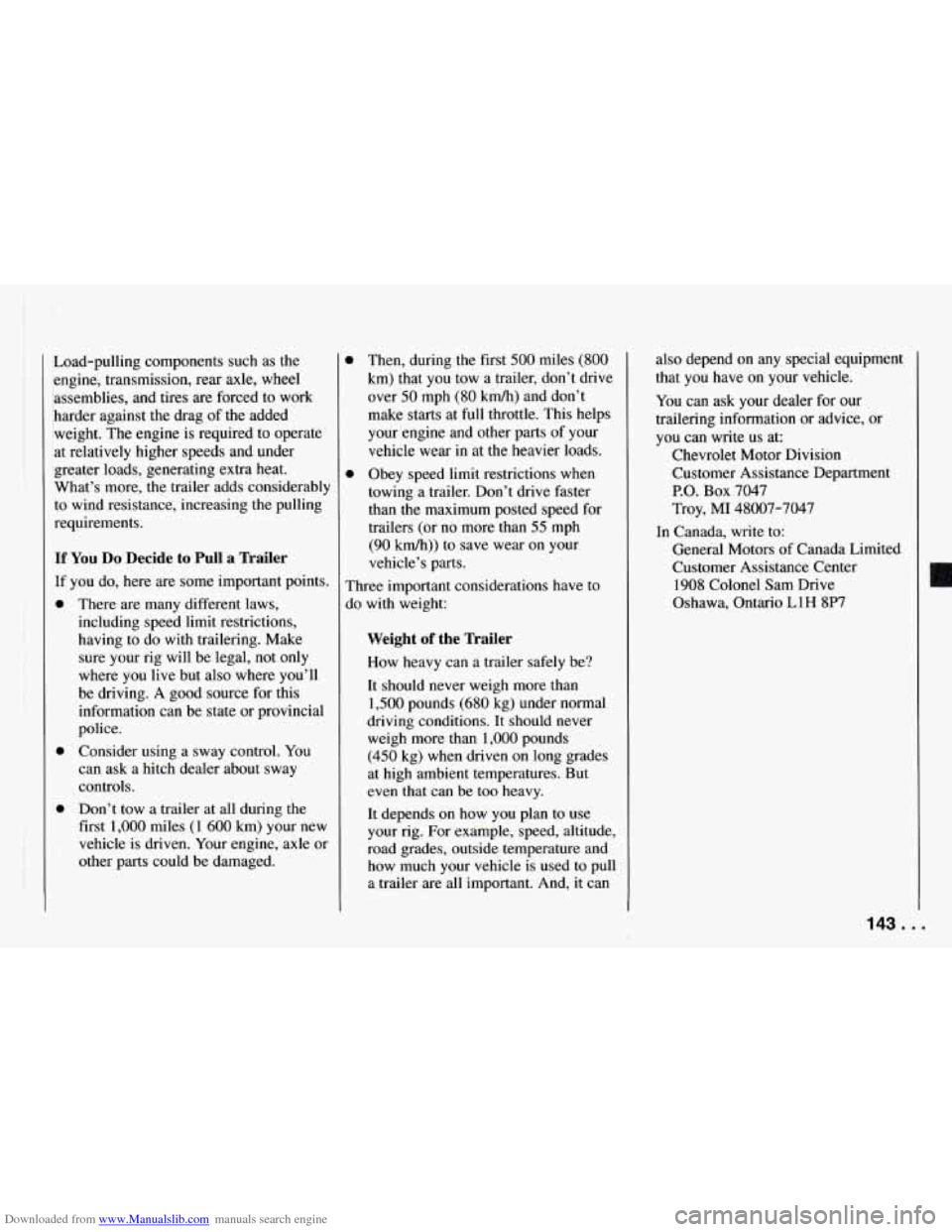
Downloaded from www.Manualslib.com manuals search engine t
Load-pulling components such as the
engine, transmission, rear axle, wheel
assemblies, and tires are forced to work
harder against the drag
of the added
weight, The engine
is required to operate
at relatively higher speeds and under
greater loads, generating extra heat.
What’s more, the trailer adds considerably
to wind resistance, increasing the pulling
requirements.
If You Do Decide to Pull a Trailer
If you do, here are some important points.
0
0
0
There are many different laws,
including speed limit restrictions,
having to do with trailering. Make
sure your rig will be legal, not only
where you live but also where you’ll
be driving. A good source for this
information can be state or provincial
police.
Consider using a sway control.
You
can ask a hitch dealer about sway
controls.
Don’t tow a trailer at all during the
first
1,000 miles (1 600 km) your new
vehicle is driven. Your engine, axle or
other parts could be damaged. Then, during
the first
500 miles (800
km) that you tow a trailer, don’t drive
over
50 mph (80 km/h) and don’t
make starts at full throttle. This helps
your engine and other parts of your
vehicle wear in at the heavier loads.
Obey speed limit restrictions when
towing a trailer. Don’t drive faster
than the maximum posted speed for
trailers (or no more than
55 mph
(90 km/h)) to save wear on your
vehicle’s parts.
Three important considerations have to
do with weight:
Weight of the Trailer
How heavy can a trailer safely be? also depend on
any special equipment
I
that you have on your vehicle.
You can ask your dealer for our
trailering information or advice, or
you can write
us at:
Chevrolet Motor Division Customer Assistance Department
P.O. Box 7047
Troy, MI 48007-7047
General Motors
of Canada Limited
Customer Assistance Center
1908 Colonel Sam Drive
Oshawa, Ontario
LlH 8P7
In Canada, write to:
It should never weigh more than
1,500 pounds (680 kg) under normal
driving conditions.
It should never
weigh more than
1,000 pounds
(450 kg) when driven on long grades
at high ambient temperatures. But
even that can be
too heavy.
It depends on how you plan to use
your rig. For example, speed, altitude,
road grades, outside temperature and
how much your vehicle is used to pull
a trailer are all important. And, it can
143. ..
Page 146 of 292
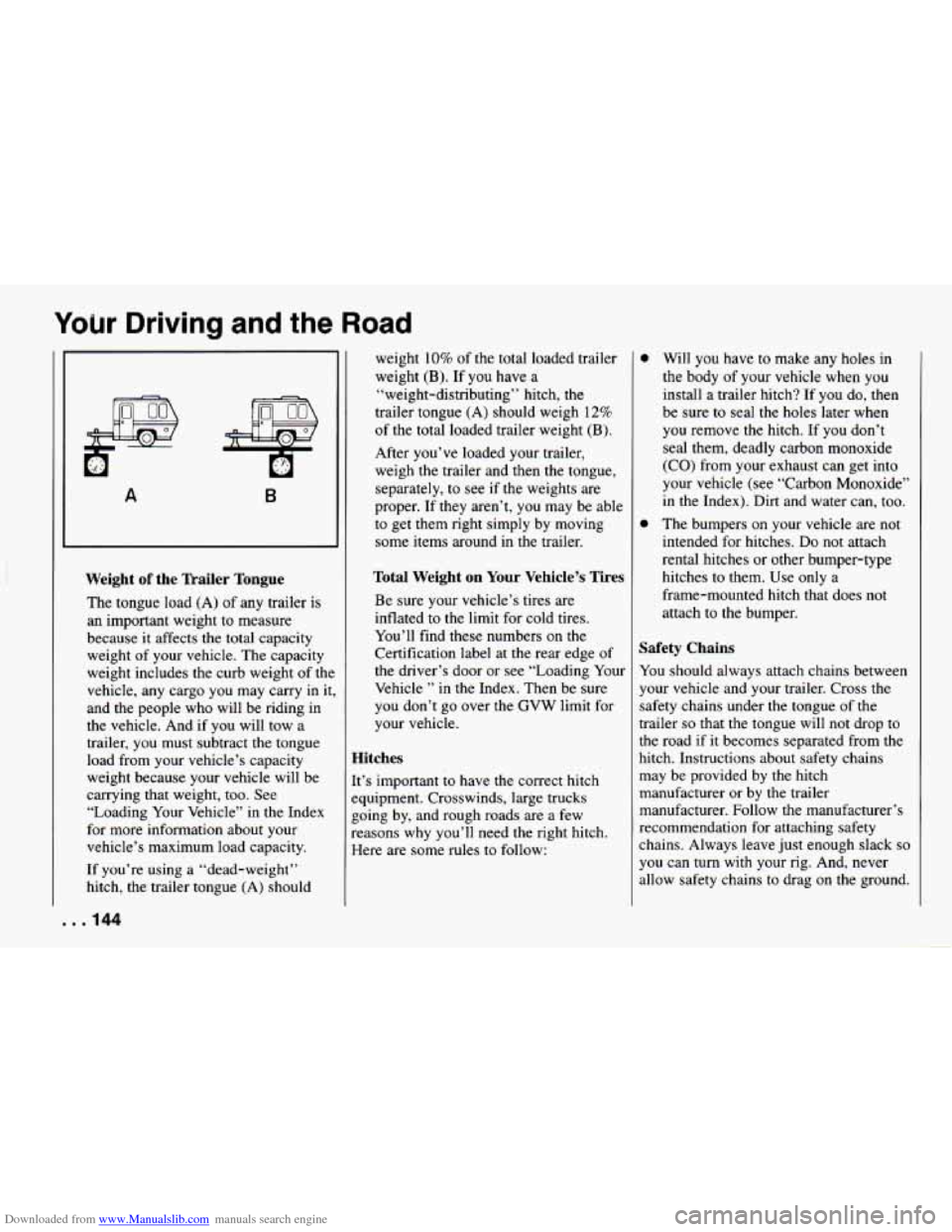
Downloaded from www.Manualslib.com manuals search engine Your Driving and the Road
A B
Weight of the Trailer Tongue
The tongue load (A) of any trailer is
an important weight to measure
because it affects the total capacity
weight of your vehicle. The capacity
weight includes the curb weight of the
vehicle, any cargo you may carry in it.
and the people who will be riding in
the vehicle. And if you will tow a
trailer, you must subtract the tongue
load from your vehicle’s capacity
weight because your vehicle will be
carrying that weight, too. See “Loading Your Vehicle” in the Index
for more information about your
vehicle’s maximum load capacity.
If you’re using a “dead-weight’’
hitch, the trailer tongue
(A) should
. .I44
weight 10% of the total loaded trailer
weight (B). If you have a
“weight-distributing” hitch,
the
trailer tongue (A) should weigh 12%
of the total loaded trailer weight
(B).
After you’ve loaded your trailer,
weigh the trailer and then the tongue,
separately, to see if the weights are
proper. If they aren’t, you may be able
to get them
right simply by moving
some items around in the trailer.
Total Weight on Your Vehicle’s Tires
Be sure your vehicle’s tires are
inflated to the limit for cold tires.
You’ll find these numbers on the
Certification label at
the rear edge of
the driver’s door or see “Loading Your
Vehicle
” in the Index. Then be sure
you don’t go over the GVW limit for
your vehicle.
Hitches
It’s important to have the correct hitch
zquipment. Crosswinds, large trucks
going by, and rough roads are a few
reasons why you’ll need the right hitch.
Here are some rules to follow:
Will you have to make any holes in
the body
of your vehicle when you
install a trailer hitch? If you do, then
be sure to seal the holes later when
you remove the hitch. If you don’t
seal them, deadly carbon monoxide
(CO) from your exhaust can get into
your vehicle (see “Carbon Monoxide”
in the Index). Dirt and water can, too.
The bumpers on your vehicle are not
intended for hitches.
Do not attach
rental hitches or other bumper-type
hitches to them. Use only a
frame-mounted hitch that does not
attach to the bumper.
Safety Chains
You should always attach chains between
your vehicle and your trailer. Cross the
safety chdins under the tongue of the
trailer
so that the tongue will not drop to
the road if it becomes separated from the
hitch. Instructions about safety chains
may be provided by the hitch
manufacturer or by the trailer
manufacturer. Follow the manufacturer’s
recommendation for attaching safety
chains. Always leave just enough slack
so
you can turn with your rig. And, never
allow safety chains to drag on the ground.
Page 147 of 292
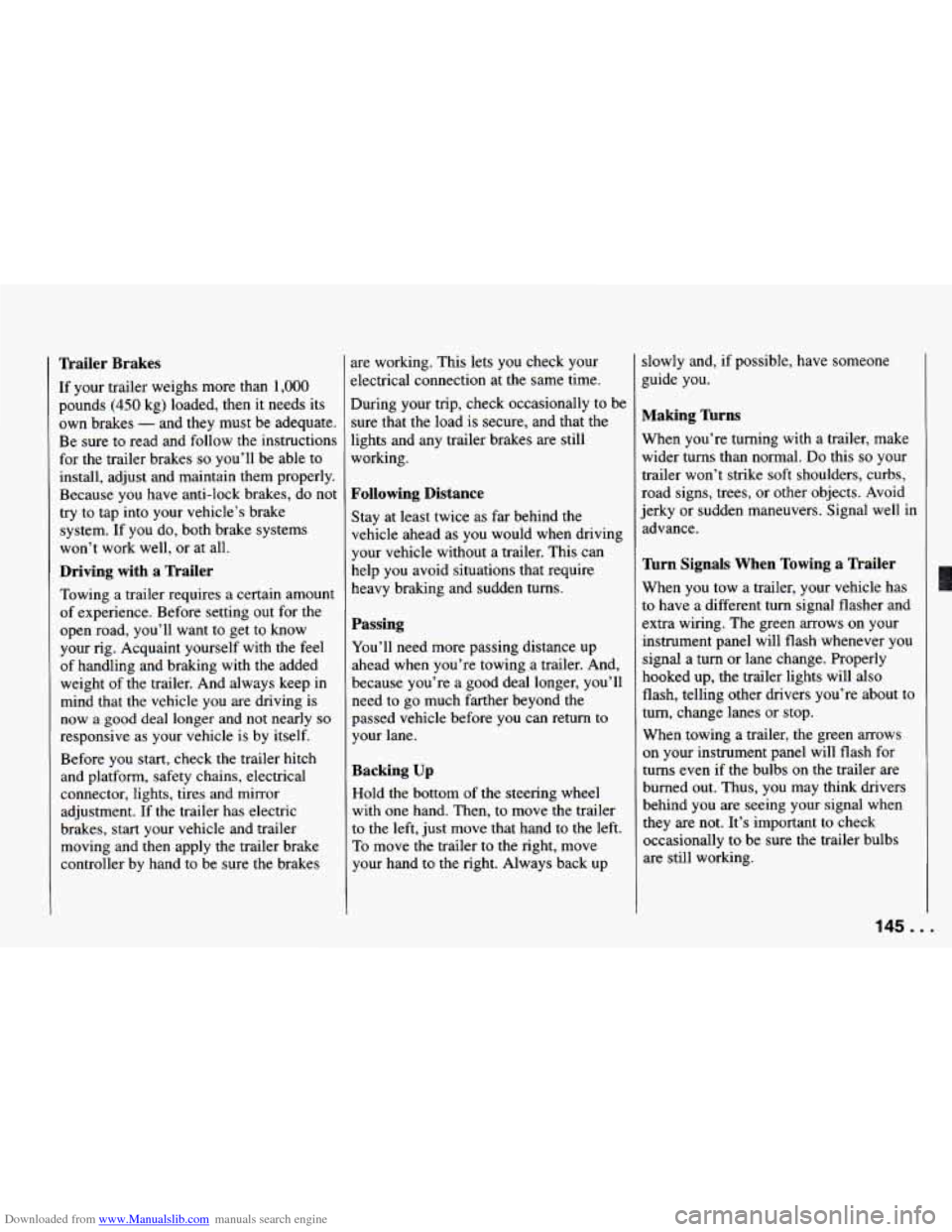
Downloaded from www.Manualslib.com manuals search engine Trailer Brakes
If your trailer weighs more than 1,000
pounds (450 kg) loaded, then it needs its
own brakes
- and they must be adequate.
Be sure to read and follow the instructions
for the trailer brakes
so you’ll be able to
install, adjust and maintain them properly.
Because you have anti-lock brakes, do not
try to tap into your vehicle’s brake
system. If you do, both brake systems
won’t work well, or at all.
Driving with a Trailer
Towing a trailer requires a certain amount
of experience. Before setting out for the
open road, you’ll want to get to know
your rig. Acquaint yourself with the feel
of handling and braking with the added
weight of the trailer. And always keep in
mind that the vehicle you are driving is
now
a good deal longer and not nearly so
responsive as your vehicle is by itself.
Before you start, check the trailer hitch
and platform, safety chains, electrical
connector, lights, tires and mirror
adjustment. If the trailer has electric
brakes, start your vehicle and trailer
moving and then apply the trailer brake
controller by hand to be sure
the brakes are working.
This lets
you check your
electrical connection at the same time.
During your trip, check occasionally to be sure that the load is secure, and that
the
lights and any trailer brakes are still
working.
Following Distance
Stay at least twice as far behind the
vehicle ahead as you would when driving
your vehicle without a trailer. This can
help you avoid situations that require
heavy braking and sudden turns.
Passing
You’ll need more passing distance up
ahead when you’re towing a trailer. And,
because you’re a good deal longer, you’ll need to go much farther beyond the
passed vehicle before you can return
to
your lane.
Backing Up
Hold the bottom of the steering wheel
with one hand. Then, to move the trailer
to the left, just move that hand to the left.
To move the trailer to the right, move
your hand to the right. Always back up slowly
and, if possible, have someone
guide you.
Making Turns
When you’re turning with a trailer, make
wider turns than normal.
Do this so your
trailer won’t strike soft shoulders, curbs,
road signs, trees, or other objects. Avoid
jerky or sudden maneuvers. Signal well in
advance.
Turn Signals When Towing a Trailer
When you tow a trailer, your vehicle has
to have a different turn signal flasher and
extra wiring. The green arrows on your
instrument panel will flash whenever you
signal a turn or lane change. Properly
hooked up, the trailer lights will also
flash, telling other drivers you’re about to
turn, change lanes or stop.
When towing a trailer, the green arrows
Dn your instrument panel will flash for
turns even if the bulbs on the trailer are
burned out. Thus, you may think drivers
behind you
are seeing your signal when
they are not. It’s important to check
occasionally to be sure the trailer bulbs
are still working.
145. I
Page 148 of 292
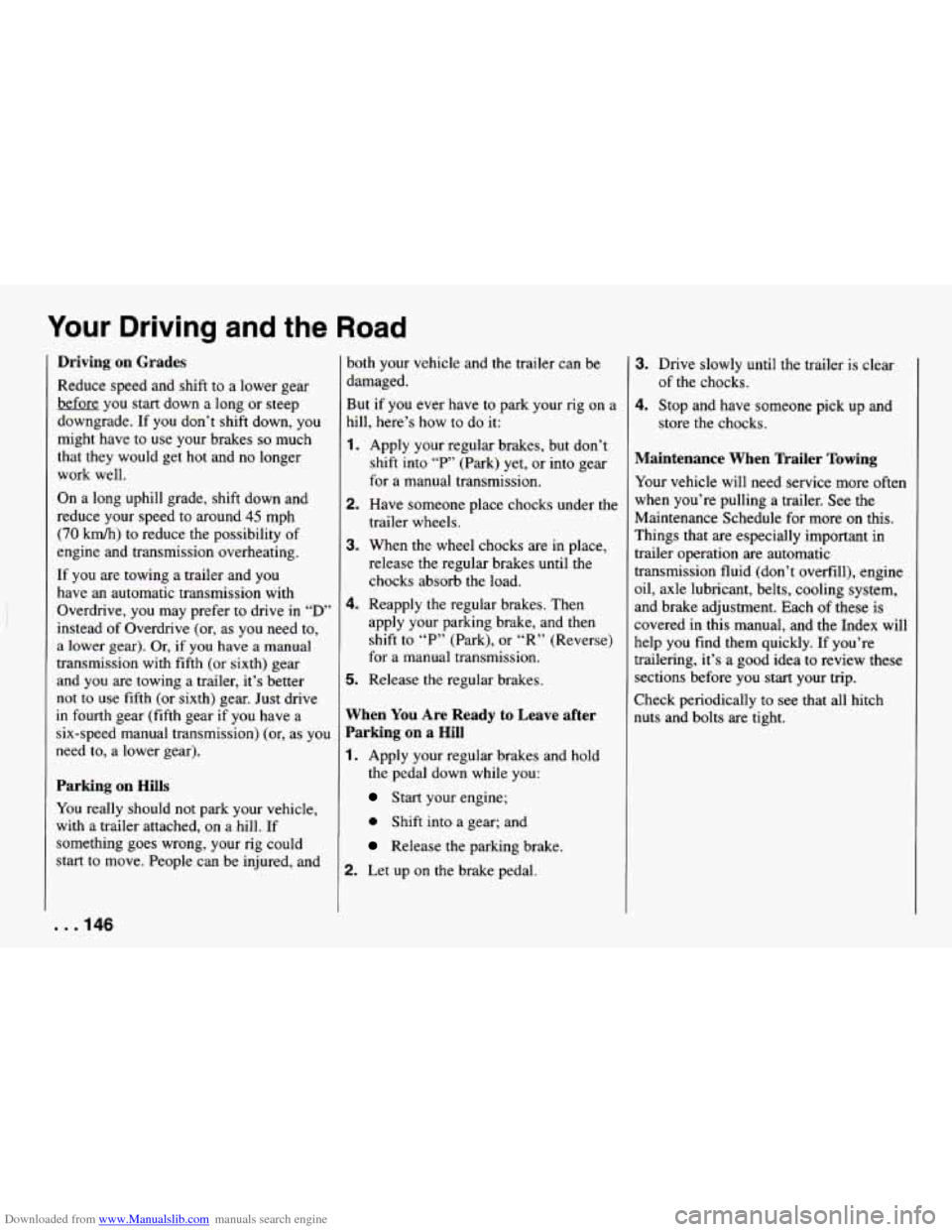
Downloaded from www.Manualslib.com manuals search engine Your Driving and the Road
Driving on Grades
Reduce speed and shift to a lower gear
before you start down a long or steep
downgrade. If you don’t shift down, you
might have to use your brakes
so much
that they would get hot and no longer
work well.
On a long uphill grade, shift down and
reduce your speed to around
45 mph
(70 kmh) to reduce the possibility of
engine and transmission overheating.
If you are towing a trailer and you
have an automatic transmission with
Overdrive, you may prefer to drive
in “D’
instead of Overdrive (or, as you need to,
a lower gear). Or,
if you have a manual
transmission with fifth (or sixth) gear
and you are towing a trailer, it’s better
not to use fifth (or sixth) gear. Just drive
in fourth gear (fifth gear if you have a
six-speed manual transmission) (or, as you
need to, a lower gear).
Parking on Hills
You really should not park your vehicle,
with a trailer attached, on a
hill. If
something goes wrong, your rig could
start to move. People can be injured, and both your vehicle and the trailer can be
damaged.
But if you
ever have to park your
rig on a
hill, here’s how to do it:
1. Apply your regular brakes, but don’t
shift into
“P’ (Park) yet, or into gear
for a manual transmission.
2. Have someone place chocks under the
3. When the wheel chocks are in place,
release the regular brakes until the
chocks absorb the load.
trailer wheels.
4. Reapply the
regular brakes. Then
apply your parking brake, and then
shift to
“P” (Park), or “R” (Reverse)
for a manual transmission.
5. Release the regular brakes.
When You Are Ready to Leave after
Parking on a Hill
1. Apply your regular brakes and hold
the pedal down while you:
Start your engine;
0 Shift into a gear; and
Release the parking brake.
2. Let up on the brake pedal.
3. Drive slowly until the trailer is clear
4. Stop ahd have someone pick up and
of the
chocks.
store the chocks.
Maintenance When Trailer Towing
Your vehicle will need service more often
when you’re pulling a trailer. See the
Maintenance Schedule for more on this.
Things that are especially important in
trailer operation are automatic
transmission fluid (don’t overfill), engine
oil, axle lubricant, belts, cooling system,
and brake adjustment. Each of these is
covered in this manual, and
the Index will
help you find them quickly. If you’re
trailering, it’s a good idea to review these
sections before you start your
trip.
Check periodically to see that all hitch
nuts and bolts are tight.
. . ,146